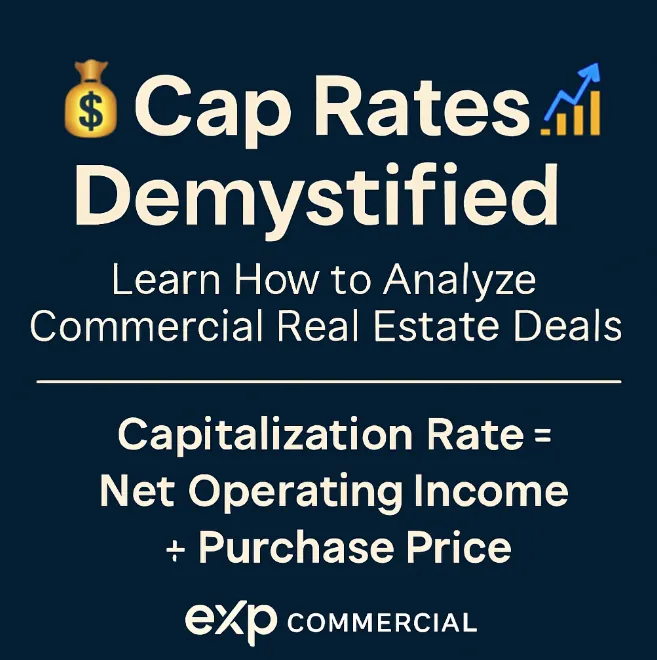
💰 Capitalization Rates Explained: A CRE Investor’s Guide 📊
💰 Capitalization Rates Explained: A CRE Investor’s Guide 📊
📈 What Is a Cap Rate? How to Analyze CRE Investments 💡
💰 Capitalization Rates Explained (and How to Use Them)
When it comes to analyzing commercial real estate (CRE) deals, capitalization rates—commonly called cap rates—remain one of the most important metrics investors and business owners should understand. Whether you’re buying, selling, or refinancing, knowing how to use cap rates can help you make smarter investment decisions.
✅ What Is a Capitalization Rate?
The capitalization rate (cap rate) measures the expected return on a commercial property based on its net operating income (NOI) compared to its purchase price.
Formula:
CapRate=NetOperatingIncomePurchasePriceCap Rate = \frac{Net Operating Income}{Purchase Price}CapRate=PurchasePriceNetOperatingIncome
For example:
If a retail property generates $250,000 in NOI and is priced at $3,125,000, the cap rate is 8%.
✅ Why Cap Rates Matter
Cap rates allow investors to:
· Compare Properties – A lower cap rate typically indicates a lower-risk investment (such as stabilized Class A office buildings).
· Gauge Market Trends – Cap rates move with interest rates, financing costs, and local demand.
· Measure Risk vs Reward – Higher cap rates usually mean higher potential returns but also greater risk.
✅ Factors That Influence Cap Rates
Several key elements can drive cap rates higher or lower, including:
· Location & Market Demand – Prime areas like Katy and Fulshear often have lower cap rates due to strong tenant demand.
· Property Type – Multifamily, retail, office, and industrial all have different risk profiles.
· Tenant Quality – A national credit tenant reduces risk, lowering the cap rate.
· Lease Terms – Longer leases provide income stability and attract lower cap rates.
· Economic Conditions – Rising interest rates or economic uncertainty tend to push cap rates higher.
✅ How to Use Cap Rates as an Investor
Cap rates are not the only metric but provide a powerful benchmark when used correctly:
1. Acquisitions – Compare cap rates across multiple markets to find opportunities.
2. Valuations – Brokers and appraisers use cap rates to estimate property value.
3. Refinancing – Lenders analyze cap rates to assess collateral risk.
4. Exit Strategy – Investors can plan disposition timing based on projected cap rate trends.
🚀 Final Thoughts
Cap rates remain a cornerstone of CRE investing, but they should never be viewed in isolation. Smart investors pair cap rate analysis with cash flow, financing terms, and long-term market outlooks.
If you’re evaluating a property purchase, 1031 exchange, or refinance in Katy, Fulshear, or Houston, understanding cap rates is essential to structuring a deal that works in your favor.
📞 Ready to discuss opportunities? Let’s connect and find the right investment strategy for you.
https://www.houstonrealestatebrokerage.com/
https://www.houstonrealestatebrokerage.com/houston-cre-navigator
https://www.commercialexchange.com/agent/653bf5593e3a3e1dcec275a6
http://expressoffers.com/[email protected]
https://app.bullpenre.com/profile/1742476177701x437444415125976000
https://author.billrapponline.com/
https://www.amazon.com/dp/B0F32Z5BH2
https://veed.cello.so/FOmzTty6oi9
© 2023-2024 Bill Rapp, Broker Associate, eXp Commercial Viking Enterprise Team
